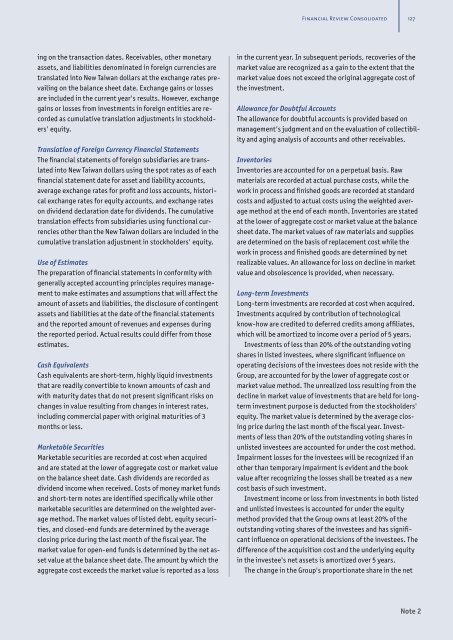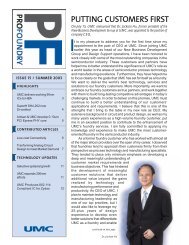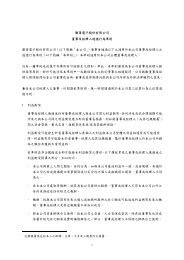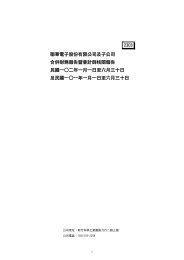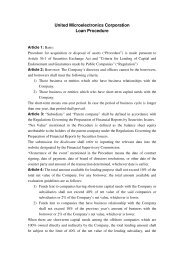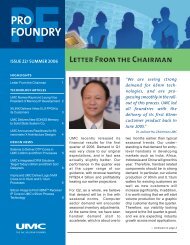Download Full Version - UMC
Download Full Version - UMC
Download Full Version - UMC
You also want an ePaper? Increase the reach of your titles
YUMPU automatically turns print PDFs into web optimized ePapers that Google loves.
Financial Review Consolidated<br />
127<br />
ing on the transaction dates. Receivables, other monetary<br />
assets, and liabilities denominated in foreign currencies are<br />
translated into New Taiwan dollars at the exchange rates prevailing<br />
on the balance sheet date. Exchange gains or losses<br />
are included in the current year's results. However, exchange<br />
gains or losses from investments in foreign entities are recorded<br />
as cumulative translation adjustments in stockholders'<br />
equity.<br />
Translation of Foreign Currency Financial Statements<br />
The financial statements of foreign subsidiaries are translated<br />
into New Taiwan dollars using the spot rates as of each<br />
financial statement date for asset and liability accounts,<br />
average exchange rates for profit and loss accounts, historical<br />
exchange rates for equity accounts, and exchange rates<br />
on dividend declaration date for dividends. The cumulative<br />
translation effects from subsidiaries using functional currencies<br />
other than the New Taiwan dollars are included in the<br />
cumulative translation adjustment in stockholders' equity.<br />
Use of Estimates<br />
The preparation of financial statements in conformity with<br />
generally accepted accounting principles requires management<br />
to make estimates and assumptions that will affect the<br />
amount of assets and liabilities, the disclosure of contingent<br />
assets and liabilities at the date of the financial statements<br />
and the reported amount of revenues and expenses during<br />
the reported period. Actual results could differ from those<br />
estimates.<br />
Cash Equivalents<br />
Cash equivalents are short-term, highly liquid investments<br />
that are readily convertible to known amounts of cash and<br />
with maturity dates that do not present significant risks on<br />
changes in value resulting from changes in interest rates,<br />
including commercial paper with original maturities of 3<br />
months or less.<br />
Marketable Securities<br />
Marketable securities are recorded at cost when acquired<br />
and are stated at the lower of aggregate cost or market value<br />
on the balance sheet date. Cash dividends are recorded as<br />
dividend income when received. Costs of money market funds<br />
and short-term notes are identified specifically while other<br />
marketable securities are determined on the weighted average<br />
method. The market values of listed debt, equity securities,<br />
and closed-end funds are determined by the average<br />
closing price during the last month of the fiscal year. The<br />
market value for open-end funds is determined by the net asset<br />
value at the balance sheet date. The amount by which the<br />
aggregate cost exceeds the market value is reported as a loss<br />
in the current year. In subsequent periods, recoveries of the<br />
market value are recognized as a gain to the extent that the<br />
market value does not exceed the original aggregate cost of<br />
the investment.<br />
Allowance for Doubtful Accounts<br />
The allowance for doubtful accounts is provided based on<br />
management's judgment and on the evaluation of collectibility<br />
and aging analysis of accounts and other receivables.<br />
Inventories<br />
Inventories are accounted for on a perpetual basis. Raw<br />
materials are recorded at actual purchase costs, while the<br />
work in process and finished goods are recorded at standard<br />
costs and adjusted to actual costs using the weighted average<br />
method at the end of each month. Inventories are stated<br />
at the lower of aggregate cost or market value at the balance<br />
sheet date. The market values of raw materials and supplies<br />
are determined on the basis of replacement cost while the<br />
work in process and finished goods are determined by net<br />
realizable values. An allowance for loss on decline in market<br />
value and obsolescence is provided, when necessary.<br />
Long-term Investments<br />
Long-term investments are recorded at cost when acquired.<br />
Investments acquired by contribution of technological<br />
know-how are credited to deferred credits among affiliates,<br />
which will be amortized to income over a period of 5 years.<br />
Investments of less than 20% of the outstanding voting<br />
shares in listed investees, where significant influence on<br />
operating decisions of the investees does not reside with the<br />
Group, are accounted for by the lower of aggregate cost or<br />
market value method. The unrealized loss resulting from the<br />
decline in market value of investments that are held for longterm<br />
investment purpose is deducted from the stockholders'<br />
equity. The market value is determined by the average closing<br />
price during the last month of the fiscal year. Investments<br />
of less than 20% of the outstanding voting shares in<br />
unlisted investees are accounted for under the cost method.<br />
Impairment losses for the investees will be recognized if an<br />
other than temporary impairment is evident and the book<br />
value after recognizing the losses shall be treated as a new<br />
cost basis of such investment.<br />
Investment income or loss from investments in both listed<br />
and unlisted investees is accounted for under the equity<br />
method provided that the Group owns at least 20% of the<br />
outstanding voting shares of the investees and has significant<br />
influence on operational decisions of the investees. The<br />
difference of the acquisition cost and the underlying equity<br />
in the investee's net assets is amortized over 5 years.<br />
The change in the Group's proportionate share in the net<br />
Note 2


